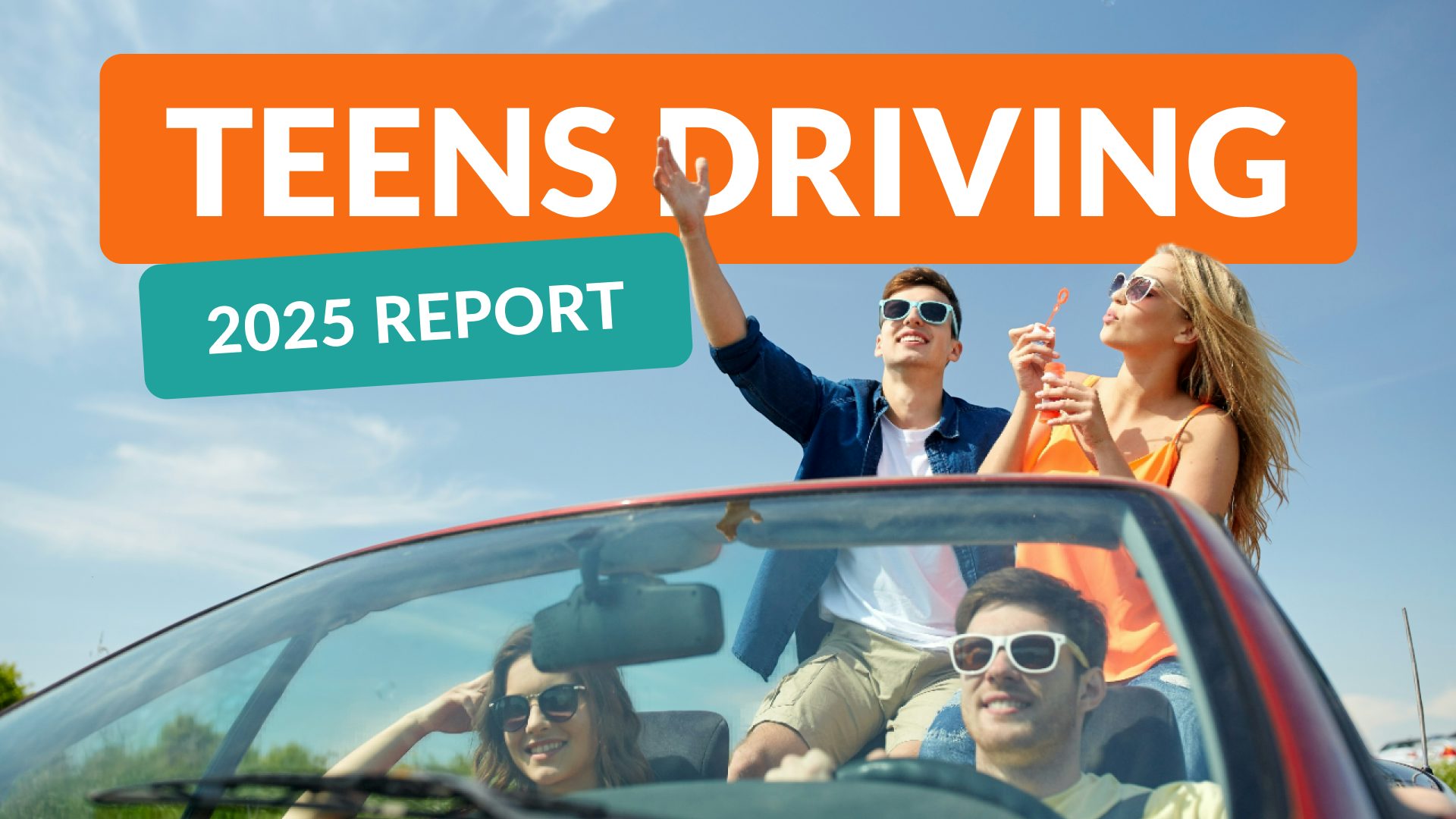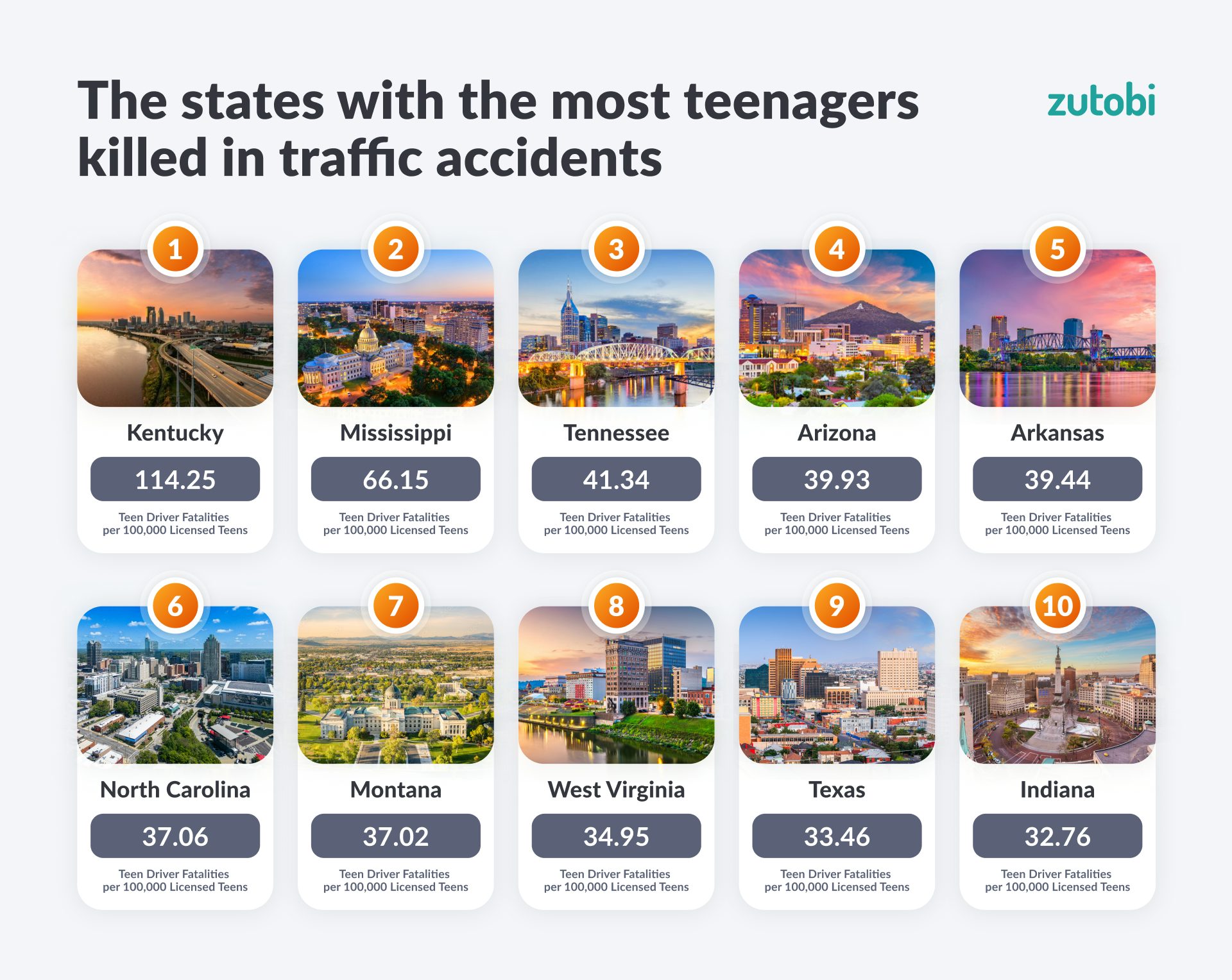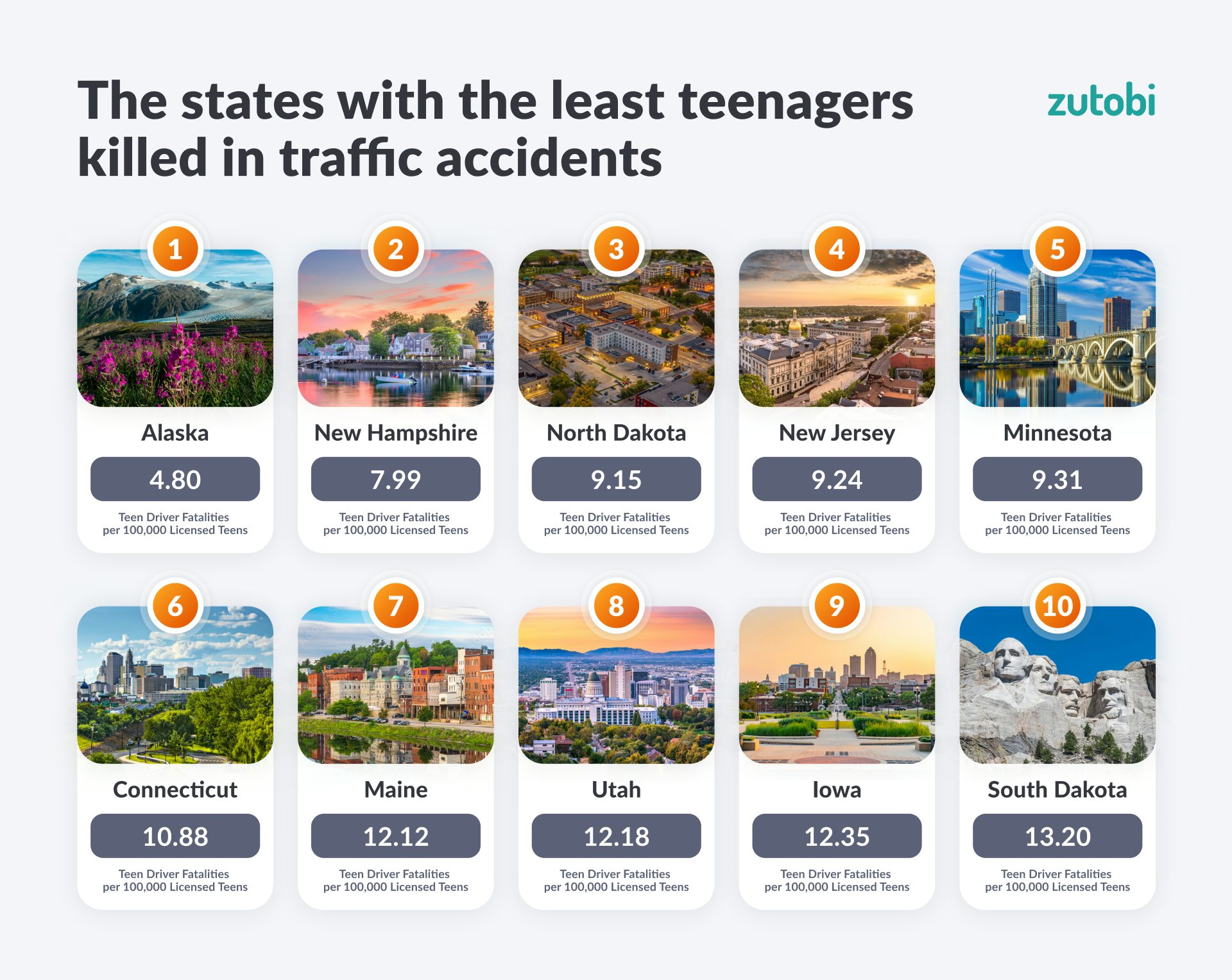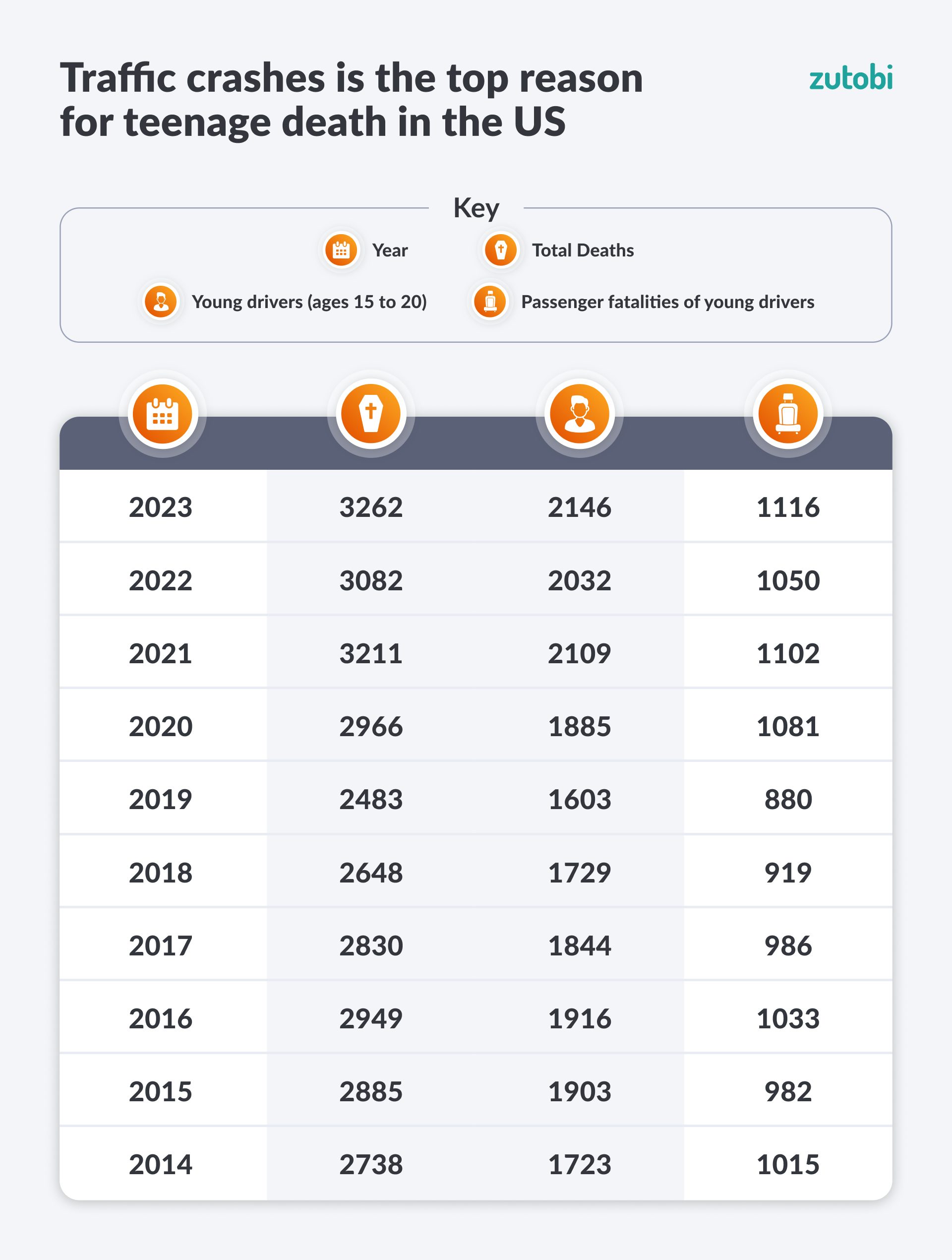
Teen Driver Report – The States with the Most and Least Teenage Driving Fatalities
Each year, thousands of teens lose their lives in car crashes, and hundreds of thousands are treated in emergency departments for injuries related to motor vehicle crashes. For years, traffic crashes have been the #1 teenage killer in America.
The Zutobi team took a deep dive into the topic. First, we examined what factors contributed to teen deaths on the road, including drinking while under the influence (DUI), speeding, distracted driving, and other causes. Then, we ranked each state from best to worst and reported the number of deaths per 100,000 teen drivers per state. Our team also looked at the historical statistics and considered what programs and initiatives may have contributed to the decrease.
Note: Driving statistics takes time to collect. This report features the latest data released in 2025.
The 2023 number remains alarmingly high
On a broader level, the number of young driver road deaths has been steadily decreasing in the last since 1982. Although we can see that there has been a sharp increase in fatalities the first year of the pandemic. The number of young driver and passenger fatalities have increased by 19.5% in 2020 compared to the previous year.
Recent data shows that 3,262 people were killed in crashes involving a teen driver between the ages of 15 and 20 in 2023. This represents a concerning 5.8% increase from the preceding year’s toll of 3,082 lives within the same age group, indicating that teen driving fatalities continue to climb post-pandemic. The figure remains disturbingly high, and compared to the pre-pandemic year of 2019, the disparity persists at 31.4%. The continued upward trend in 2023 suggests that the pandemic’s impact on teen driving safety has not yet been reversed, with fatalities now reaching levels not seen since the early 2010s.
| Year | Total deaths | Young drivers (ages 15 to 20) | Passenger fatalities of young drivers |
|---|---|---|---|
2023 | 3262 | 2146 | 1116 |
| 2022 | 3082 | 2032 | 1050 |
| 2021 | 3211 | 2109 | 1102 |
| 2020 | 2966 | 1885 | 1081 |
| 2019 | 2483 | 1603 | 880 |
| 2018 | 2648 | 1729 | 919 |
| 2017 | 2830 | 1844 | 986 |
| 2016 | 2949 | 1916 | 1033 |
| 2015 | 2885 | 1903 | 982 |
| 2014 | 2738 | 1723 | 1015 |
| 2013 | 2765 | 1696 | 1069 |
| 2012 | 2940 | 1880 | 1060 |
| 2011 | 3187 | 1993 | 1194 |
| 2010 | 3298 | 1965 | 1333 |
| 2009 | 3799 | 2343 | 1456 |
| 2008 | 4404 | 2742 | 1662 |
| 2007 | 5234 | 3190 | 2044 |
| 2006 | 5667 | 3490 | 2177 |
| 2005 | 5671 | 3474 | 2197 |
| 2004 | 6036 | 3634 | 2402 |
| 2003 | 6074 | 3675 | 2399 |
| 2002 | 6403 | 3838 | 2565 |
| 2001 | 6146 | 3617 | 2529 |
| 2000 | 6156 | 3621 | 2535 |
| 1999 | 6142 | 3564 | 2578 |
| 1998 | 5920 | 3431 | 2489 |
| 1997 | 5993 | 3358 | 2635 |
| 1996 | 6024 | 3389 | 2635 |
| 1995 | 5927 | 3348 | 2579 |
| 1994 | 5962 | 3449 | 2513 |
| 1993 | 5670 | 3228 | 2442 |
| 1992 | 5515 | 3153 | 2362 |
| 1991 | 6192 | 3573 | 2619 |
| 1990 | 6836 | 4053 | 2783 |
| 1989 | 7094 | 4222 | 2872 |
| 1988 | 7594 | 4619 | 2975 |
| 1987 | 7541 | 4582 | 2959 |
| 1986 | 7756 | 4658 | 3098 |
| 1985 | 6893 | 4281 | 2612 |
| 1984 | 7309 | 4525 | 2784 |
| 1983 | 6968 | 4252 | 2716 |
| 1982 | 7327 | 4526 | 2801 |
What are the main causes of fatal teen driving accidents?
Young drivers are at greater risk for accidents, injuries, and death as a result of motor vehicle crashes because of their inexperience and immaturity. That’s why many states have more stringent laws for teen drivers in an effort to provide greater protection. Top causes of fatalities are:
- Alcohol Consumption: Although alcohol usage is illegal for those under 21 years of age, young drivers’ consumption of alcohol remains a large reason for teenage traffic fatalities. 687 teen drivers were killed in DUI crashes in 2023, showing an 8.7% increase from 632 in 2022. According to multiple studies gathered by the Insurance Institute for Highway Safety (IIHS), more young people die in fatal crashes when the drinking age is lowered.
- Speeding continues to be a major factor contributing to teenage traffic fatalities in the United States. According to new data, in 2023 alone, a concerning number of 1,984 teen drivers lost their lives in speeding-related crashes, representing an 8.7% increase from the 1,826 speeding-related deaths in 2022. These tragic statistics highlight the need for heightened awareness and effective measures to address the dangers of exceeding speed limits among young drivers.
- Distracted Driving: Teenagers are naturally distracted individuals, so it’s no surprise that distracted driving is a top cause of traffic fatalities for teens. Distracted driving involves doing another activity while driving, including texting, calling friends, eating, talking with other passengers, and putting on makeup. Speaking on a mobile phone while driving doubles the crash risk, while texting increases the crash risk by up to six times. In 2023, 348 teens were killed in motor vehicle accidents due to distracted driving, showing a significant 17.6% increase from 296 deaths in 2022.
- Seat Belts: Seat belt use is lowest among teen drivers. In fact, the majority of teenagers involved in fatal crashes are unbuckled. According to the NHTSA data, in 2023, 50% of teen drivers who died were unbuckled. Even more troubling, when the teen driver involved in the fatal crash was unbuckled, nine out of 10 of the passengers who died were also unbuckled.
| State | Impaired/Drunk Driving | Distracted Driving | Speeding |
|---|---|---|---|
| Alabama | 17 | 7 | 46 |
| Alaska | 1 | 0 | 4 |
| Arizona | 28 | 11 | 77 |
| Arkansas | 9 | 1 | 15 |
| California | 77 | 15 | 180 |
| Colorado | 19 | 7 | 53 |
| Connecticut | 5 | 0 | 10 |
| Delaware | 2 | 1 | 9 |
| District of Columbia | 1 | 0 | 2 |
| Florida | 37 | 21 | 54 |
| Georgia | 19 | 2 | 48 |
| Hawaii | 2 | 3 | 4 |
| Idaho | 4 | 4 | 12 |
| Illinois | 25 | 12 | 74 |
| Indiana | 15 | 9 | 55 |
| Iowa | 11 | 2 | 18 |
| Kansas | 15 | 21 | 25 |
| Kentucky | 14 | 16 | 15 |
| Louisiana | 9 | 26 | 34 |
| Maine | 1 | 3 | 10 |
| Maryland | 2 | 2 | 25 |
| Massachusetts | 7 | 5 | 23 |
| Michigan | 15 | 6 | 49 |
| Minnesota | 8 | 3 | 25 |
| Mississippi | 13 | 1 | 25 |
| Missouri | 19 | 12 | 82 |
| Montana | 7 | 3 | 13 |
| Nebraska | 4 | 2 | 14 |
| Nevada | 7 | 2 | 11 |
| New Hampshire | 1 | 1 | 4 |
| New Jersey | 4 | 16 | 29 |
| New Mexico | 5 | 14 | 19 |
| New York | 20 | 13 | 60 |
| North Carolina | 22 | 0 | 105 |
| North Dakota | 0 | 0 | 1 |
| Ohio | 21 | 4 | 45 |
| Oklahoma | 14 | 7 | 43 |
| Oregon | 9 | 7 | 24 |
| Pennsylvania | 12 | 7 | 79 |
| Rhode Island | 2 | 1 | 6 |
| South Carolina | 16 | 1 | 57 |
| South Dakota | 1 | 1 | 5 |
| Tennessee | 18 | 6 | 59 |
| Texas | 101 | 48 | 264 |
| Utah | 5 | 2 | 20 |
| Vermont | 2 | 0 | 3 |
| Virginia | 11 | 6 | 51 |
| Washington | 17 | 9 | 40 |
| West Virginia | 3 | 1 | 18 |
| Wisconsin | 8 | 3 | 33 |
| Wyoming | 2 | 4 | 7 |
| Total | 687 | 348 | 1984 |
The states with the most teenagers killed in traffic accidents
For the fourth year in a row, Kentucky has the most teenage driving fatalities in the country, with 114.25 deaths per 100,000 teenage drivers.
The second worst state is Mississippi (66.15), followed by Tennessee (41.34), Arizona (39.93), Arkansas (39.44), North Carolina (37.06), Montana (37.02), West Virginia (34.95), Texas (33.46), and Indiana (32.76).

The states with the least teenagers killed in traffic accidents
Alaska continues to have the lowest teen driving fatality rate with 4.80 deaths per 100,000 teenage drivers, followed by New Hampshire (7.99), North Dakota (9.15), New Jersey (9.24), Minnesota (9.31), Connecticut (10.88), Maine (12.12), Utah (12.18), Iowa (12.35), and South Dakota (13.20).

The complete list of teenage traffic fatalities, by state
| State | Male Teen Drivers Killed In Crashes | Female Teen Drivers Killed In Crashes | Total Teenage Drivers Killed in Crashes | Teen Driver Fatalities per 100,000 Licensed Teens |
|---|---|---|---|---|
| Kentucky | 26 | 15 | 41 | 114.25 |
| Mississippi | 42 | 14 | 56 | 66.15 |
| Tennessee | 69 | 19 | 88 | 41.34 |
| Arizona | 54 | 16 | 70 | 39.93 |
| Arkansas | 24 | 7 | 31 | 39.44 |
| North Carolina | 66 | 18 | 84 | 37.06 |
| Montana | 11 | 5 | 16 | 37.02 |
| West Virginia | 19 | 0 | 19 | 34.95 |
| Texas | 204 | 46 | 250 | 33.46 |
| Indiana | 50 | 15 | 65 | 32.76 |
| Missouri | 47 | 16 | 63 | 32.59 |
| Florida | 129 | 29 | 158 | 32.56 |
| Kansas | 28 | 11 | 39 | 31.24 |
| New Mexico | 14 | 3 | 17 | 30.42 |
| Colorado | 42 | 5 | 47 | 28.69 |
| Alabama | 43 | 17 | 60 | 28.21 |
| Oklahoma | 31 | 9 | 40 | 27.01 |
| Louisiana | 24 | 8 | 32 | 26.55 |
| Nevada | 12 | 3 | 15 | 24.30 |
| Pennsylvania | 57 | 12 | 69 | 22.68 |
| California | 151 | 30 | 181 | 22.55 |
| South Carolina | 43 | 8 | 51 | 22.10 |
| Wyoming | 4 | 1 | 5 | 21.95 |
| Washington | 36 | 9 | 45 | 21.04 |
| Nebraska | 12 | 4 | 16 | 20.37 |
| Rhode Island | 5 | 0 | 5 | 20.36 |
| Georgia | 46 | 20 | 66 | 20.34 |
| Maryland | 16 | 5 | 21 | 19.97 |
| Ohio | 48 | 18 | 66 | 19.24 |
| Illinois | 58 | 16 | 74 | 18.85 |
| Virginia | 31 | 10 | 41 | 18.38 |
| Vermont | 3 | 0 | 3 | 17.90 |
| Idaho | 8 | 6 | 14 | 17.80 |
| Delaware | 7 | 0 | 7 | 17.79 |
| New York | 42 | 8 | 50 | 16.99 |
| Wisconsin | 27 | 6 | 33 | 16.73 |
| Michigan | 40 | 8 | 48 | 16.52 |
| Hawaii | 4 | 0 | 4 | 16.22 |
| Oregon | 14 | 3 | 17 | 15.20 |
| Massachusetts | 19 | 4 | 23 | 14.26 |
| South Dakota | 5 | 2 | 7 | 13.20 |
| Iowa | 17 | 7 | 24 | 12.35 |
| Utah | 13 | 6 | 19 | 12.18 |
| Maine | 3 | 1 | 4 | 12.12 |
| Connecticut | 9 | 1 | 10 | 10.88 |
| Minnesota | 18 | 5 | 23 | 9.31 |
| New Jersey | 18 | 4 | 22 | 9.24 |
| North Dakota | 3 | 0 | 3 | 9.15 |
| New Hampshire | 2 | 1 | 3 | 7.99 |
| Alaska | 1 | 0 | 1 | 4.80 |
How can this be improved?
Teen drivers aren’t involved in vehicle crashes due to ignorance of basic road rules or safe driving practices. Rather, studies highlight that crashes often result from inexperience and risk-taking behavior, underscoring the need for enhanced education quality.
“The alarming increase in teen driving fatalities shows that traditional driver education methods are failing our young people,” states Lucas Waldenback, co-founder of Zutobi, a leading EdTech company in driver’s education. “We need to revolutionize how we teach driving safety – moving beyond outdated textbooks to create experiences that truly resonate with digital natives.”
Modern driver education platforms like the Zutobi app are pioneering this transformation through engaging videos, interactive quizzes, and immersive simulations that make learning both effective and enjoyable. The quizzes within hazard perception tasks allow educators to objectively track accuracy scores, showing measurable improvements in judgment and decision-making skills while allowing students to work on these critical abilities in a safe and controlled environment.
Parents play an irreplaceable role in shaping safe driving habits, yet they are often sidelined in the formal education process. Research consistently shows that teens whose parents are actively involved in their driving education demonstrate significantly lower crash rates and better long-term safety behaviors. Zutobi’s “Parent-Teen” Training Guide addresses this gap by providing a step-by-step driving curriculum specifically designed for supervised practice sessions between parents and teens, ensuring consistent messaging and structured skill development at home.
“The future of teen driver safety lies in creating an ecosystem where technology enhances learning, parents are empowered partners, and students are genuinely engaged in their own safety education,” concludes Waldenback. “Only through this comprehensive approach can we hope to reverse the troubling trends we’re seeing in teen fatality statistics.”
By adopting innovative educational approaches and integrating technology with parental involvement, we can collectively work towards a safer driving environment for teenagers.

Previous reports
Methodology
Most of the injury data has been gathered using the NHTSA crash data tool, and the Fatality and Injury Reporting System (FIRST). To find the number of licensed teen drivers, we looked at data from the Federal Highway Administration.

600+ exam-like questions and practice tests
Easy summarized DMV handbook
America’s #1 driver’s ed app with a 95.8% pass rate
Recommended articles
Ace your DMV test, guaranteed
Want to Be the Top School in Your Area?
- Simple & automated admin
- More time for teaching
- #1 learning materials for students


